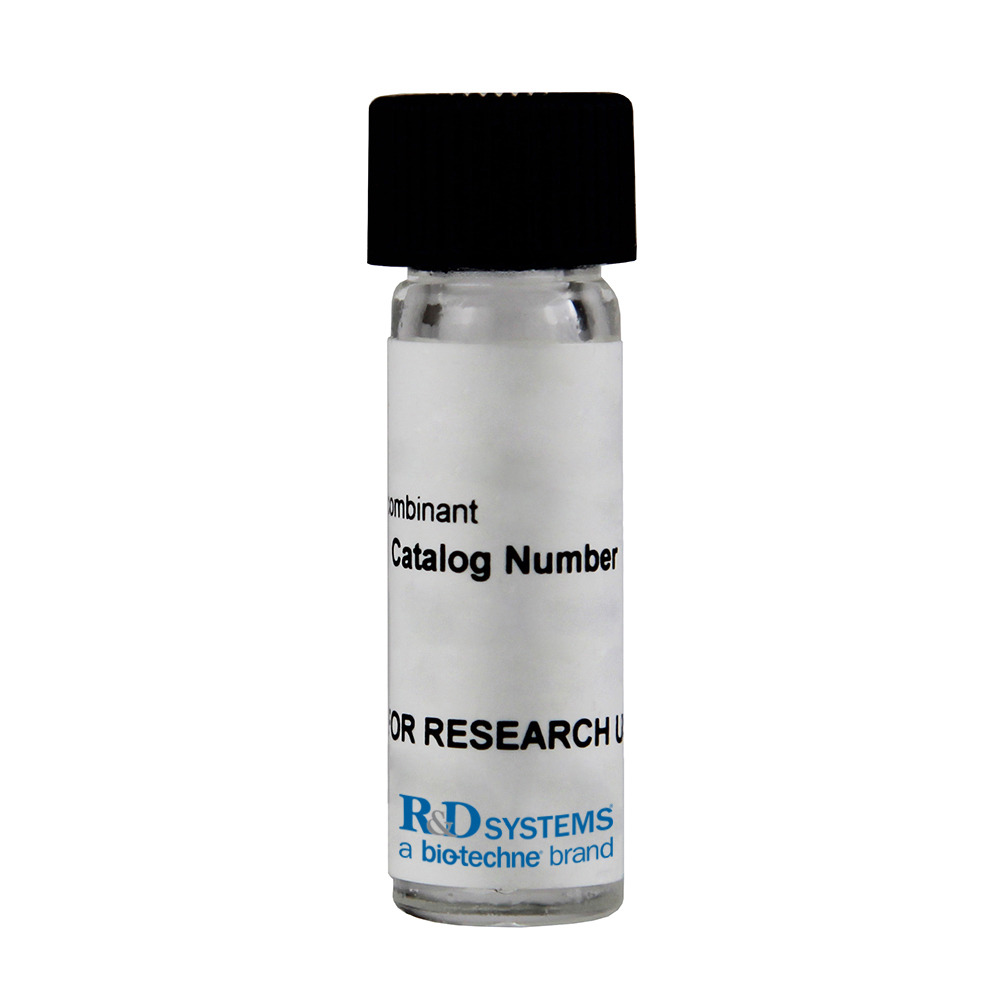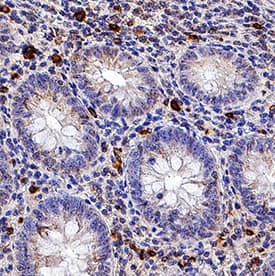Human Cyr61/CCN1 Antibody Summary
Ala22-Asp381
Accession # O00622
Customers also Viewed
Applications
under non-reducing conditions only
Please Note: Optimal dilutions should be determined by each laboratory for each application. General Protocols are available in the Technical Information section on our website.
Preparation and Storage
- 12 months from date of receipt, -20 to -70 °C as supplied.
- 1 month, 2 to 8 °C under sterile conditions after reconstitution.
- 6 months, -20 to -70 °C under sterile conditions after reconstitution.
Background: Cyr61/CCN1
Cyr61, also known as CCN1, is a 40 - 45 kDa matricellular glycoprotein that plays an important role in cellular adhesion and migration (1). Cyr61 consists of an IGFBP domain, a VWF type C domain, a TSP type I domain, and a cysteine knot domain (2). Mature human Cyr61 shares 93% amino acid sequence identity with mouse and rat Cyr61. It is widely expressed during development and in adult tissues (2, 3). Cyr61 associates with the extracellular matrix (ECM) and with many cell surface molecules including Integrins alpha V beta 3, alpha V beta 5, alpha M beta 2, and alpha 6 beta 1, Syndecan-4, and heparan sulfate proteoglycans (1, 3). Cyr61 mediates the adhesion and migration of multiple cell types and also promotes vascular endothelial cell tubule formation (4 - 6). Plasmin cleavage of ECM-bound Cyr61 releases a 28 kDa N-terminal fragment which retains the ability to promote endothelial cell migration (7). Cyr61 exhibits both tumorigenic and tumor suppressor properties. It is upregulated and promotes tumorigenesis, angiogenesis, and metastasis in breast, renal, gastric, squamous cell, and colorectal carcinomas as well as in glioma (8 - 12). In contrast, when downregulated, it suppresses tumor growth in endometrial, hepatic, and non-small cell lung cancers (8, 13, 14). Cyr61 is also upregulated in injured skin and bone where it induces the expression of growth factors, cytokines, proteases, and integrins involved in wound repair (15, 16).
- Chen, Y. and X.Y. Du (2007) J. Cell. Biochem. 100:1337.
- Jay, P. et al. (1997) Oncogene 14:1753.
- Feng, P. et al. (2008) Int. J. Biochem. Cell Biol. 40:98.
- Chen, N. et al. (2000) J. Biol. Chem. 275:24953.
- Leu, S-J. et al. (2002) J. Biol. Chem. 277:46248.
- Schutze, N. et al. (2007) BMC Cell Biol. 8:45.
- Pendurthi, U.R. et al. (2005) Cancer Res. 65:9705.
- O'Kelly, J. et al. (2008) Int. J. Oncol. 33:59.
- Chintalapudi, M.R. et al. (2008) Carcinogenesis 29:696.
- Xie, D. et al. (2004) Cancer Res. 64:1987.
- Lin, M-T. et al. (2007) J. Biol. Chem. 282:34594.
- Monnier, Y. et al. (2008) Cancer Res. 68:7323.
- Tong, X. et al. (2001) J. Biol. Chem. 276:47709.
- Chien, W. et al. (2004) J. Biol. Chem. 279:53087.
- Hadjiargyrou, M. et al. (2000) J. Bone Miner. Res.15:1014.
- Chen, C-C. et al. (2001) J. Biol. Chem. 276:47329.
Product Datasheets
Citations for Human Cyr61/CCN1 Antibody
R&D Systems personnel manually curate a database that contains references using R&D Systems products. The data collected includes not only links to publications in PubMed, but also provides information about sample types, species, and experimental conditions.
5
Citations: Showing 1 - 5
Filter your results:
Filter by:
-
Differential Effects of MicroRNAs on Glioblastoma Growth and Migration.
Authors: Jeansonne D, Pacifici M, Lassak A et al.
Genes (Basel)
-
Proteomics profiling identifies extracellular vesicles' cargo associated with tumour cell induced platelet aggregation
Authors: N McNamee, LR de la Fuen, MJ Santos-Mar, L O'Driscoll
BMC Cancer, 2022-09-29;22(1):1023.
Species: Human
Sample Types: Cell Lysates
Applications: Western Blot -
Transcriptomic analysis reveals cell apoptotic signature modified by heparanase in melanoma cells
Authors: T Song, D Spillmann
J. Cell. Mol. Med., 2019-05-02;0(0):.
Species: Human
Sample Types: Cell Lysates
Applications: Western Blot -
Anti-CTGF single-chain variable fragment dimers inhibit human airway smooth muscle (ASM) cell proliferation by down-regulating p-Akt and p-mTOR levels.
Authors: Gao W, Cai L, Xu X, Fan J, Xue X, Yan X, Qu Q, Wang X, Zhang C, Wu G
PLoS ONE, 2014-12-05;9(12):e113980.
Species: Human
Sample Types: Recombinant Protein
Applications: ELISA Development -
CYR61 and alphaVbeta5 integrin cooperate to promote invasion and metastasis of tumors growing in preirradiated stroma.
Authors: Monnier Y, Farmer P, Bieler G, Imaizumi N, Sengstag T, Alghisi GC, Stehle JC, Ciarloni L, Andrejevic-Blant S, Moeckli R, Mirimanoff RO, Goodman SL, Delorenzi M, Ruegg C
Cancer Res., 2008-09-15;68(18):7323-31.
Species: Human
Sample Types: Cell Lysates
Applications: Western Blot
FAQs
No product specific FAQs exist for this product, however you may
View all Antibody FAQsIsotype Controls
Reconstitution Buffers
Secondary Antibodies
Reviews for Human Cyr61/CCN1 Antibody
There are currently no reviews for this product. Be the first to review Human Cyr61/CCN1 Antibody and earn rewards!
Have you used Human Cyr61/CCN1 Antibody?
Submit a review and receive an Amazon gift card.
$25/€18/£15/$25CAN/¥75 Yuan/¥2500 Yen for a review with an image
$10/€7/£6/$10 CAD/¥70 Yuan/¥1110 Yen for a review without an image














